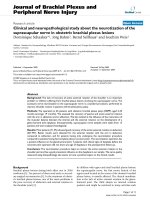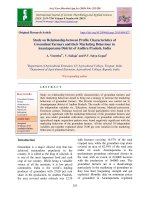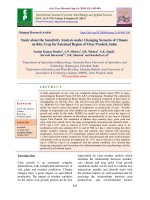Study about the sensitivity analysis under changing scenario of climate on rice crop for Faizabad region of Uttar Pradesh, India
Bạn đang xem bản rút gọn của tài liệu. Xem và tải ngay bản đầy đủ của tài liệu tại đây (260.46 KB, 7 trang )
Int.J.Curr.Microbiol.App.Sci (2019) 8(5): 943-949
International Journal of Current Microbiology and Applied Sciences
ISSN: 2319-7706 Volume 8 Number 05 (2019)
Journal homepage:
Original Research Article
/>
Study about the Sensitivity Analysis under Changing Scenario of Climate
on Rice Crop for Faizabad Region of Uttar Pradesh, India
Sachin Kumar Shukla1, A.N. Mishra1, S.R. Mishra1, A.K. Singh1,
Sarvesh Baranwal1*, S.K. Sharma1 and Kanhaiya Lal2
1
Department of Agricultural Meteorology, Narendra Deva University of Agriculture and
Technology, Kumarganj, Faizabad, India
2
Department of Genetics and Plant Breeding, Chandra Shekhar Azad University of
Agriculture & Technology, Kanpur-208002, Uttar Pradesh, India
*Corresponding author
ABSTRACT
Keywords
Sensitivity analysis,
Climate,
Rice crop,
Faizabad region
Article Info
Accepted:
10 April 2019
Available Online:
10 May 2019
A field experiment of rice crop was conducted during Kharif season 2016 at Agrometeorological Research Farm of N.D.U.A&T, of Kumarganj, Faizabad. The experiment
was conducted in Randomized Block Design. The treatment comprised of three dates of
Transplanting viz. 5th July (D1); 15th July (D2) and 25th July (D3) with three varieties
viz. NDR-80 (V1); Pant Dhan-4 (V2) and Swarna (V3). In this study, DSSAT-CERES
model was used to assess the impact of temperature on productivity of crop. Possible
changes in temperature and solar radiation are expected to significantly impact the crop
growth and yields. In this study, CERES rice model was used to assess the impact of
temperature and solar radiation on physiology and productivity of rice crop at Faizabad
region, Uttar Pradesh. The simulation of anthesis days, maturity days, grain yield and
straw yield were carried out for the range of temperature (maximum and minimum both) 0.5°C and +1.5°C with an interval of 0.5°C temperature from normal, alone or in
combination with solar radiation ±0.5, ±1 and ±1.5MJ m-2 day-1 while keeping the other
climate variables constant. Anthesis days and maturity days reduced with increasing
temperature. At increase of 1.5°C temperature, anthesis and maturity occurred 10 days and
11 days earlier from normal, respectively. Grain yield decreased and straw yield increased
concurrently with an increase in temperature by 1.5°C and an increase in solar radiation
(up to 1.5MJ m-2 day-1) in comparison with the normal conditions. It is inferred that
increasing temperature and decreasing solar radiation hampers the crop phenology and the
productivity in Faizabad region.
represented by crop–weather models which
facilitate the relationship between weather,
soil, climate and crop yield. Crop growth
simulation model can be used to evaluate key
interactions quickly and identify traits with
the greatest impact on yield potential and for
assessing the relationships between crop
productivity and environmental factors
Introduction
Crop growth is an extremely complex
phenomenon with complicated interactions of
soil, plant and weather conditions. Climate
changes have a great impact on agricultural
production. The impact of weather variables
on the entire crop growth period can be best
943
Int.J.Curr.Microbiol.App.Sci (2019) 8(5): 943-949
(Aggarwal et al., 1997). Crop growth
simulation models are quantitative tool based
on scientific knowledge that can evaluate the
effect of climatic, edaphic, hydrological and
agronomic factors on crop growth and yield.
Boote et al (1996). India ranked first in area
and second in production of rice in the world.
The productivity of rice is largely affected by
a set of weather variables among which solar
radiation and temperature play a significant
role. Agrometeorological models are defined
as the product of two or more weather factors
each representing functioning between yield
and weather. These models do not require
hypothesis of the plant and environment
process. Thus the input requirement is less
stringent but the output information is more
dependent on the input data. The crop
duration under different dates of transplanting
are greatly influenced by temperature and
may be estimated by accumulated heat units
(Gouri et al., 2005). Several studies have
shown that the total drymatter (TDM)
produced by a crop cultivar is directly
proportional
to
the
amount
of
photosynthetically active radiation (PAR)
intercepted by it. The quantum of intercepted
PAR depends on life-duration of the cultivar
from ground shading to physiological
maturity and its leaf-architecture and the
temporal march of solar radiation regime in
the crop period. The ground-shading stage is a
physical and not a physiological one. Time
from sowing to ground shading stage is
governed by initial population density and
temperature. For a given location and season,
the duration from ground average to
physiological maturity will be varietaldependant. The beneficial effect of CO2 rise
on growth and yield of crops is nullified by
the rising temperature, Basically competition
between the two abiotic elements only decide
the impact on growth and yield of crops,
especially in irrigated environments. Under
rainfed and water limited environments,
precipitation will also be a deciding factor
along with temperature and carbon dioxide
concentration. Agricultural productivity in
majorly affected by climate change in two
ways: one, directly, due to changes in
temperature, precipitation or CO2 levels and
two, indirectly, through changes in soil health
(physical,
chemical
and
biological),
distribution and frequency of infestation by
pests, insects, diseases or weeds. The main
goal of a crop simulation model is to estimate
crop
production,
resource
use
and
environmental impact as a function of local
weather and soil conditions and crop
management (Hoogenboom, 2000). In India,
substantial work has been done in recent
decades aimed at understanding the nature
and magnitude of change in yield of different
crops using the crop simulation model and
remote sensing technique (Mall et al., 2006;
Aggarwal et al., 2008; Patel et al., 2010;
Singh et al., 2010; Kumar et al., 2010)
Materials and Methods
The present study was carried out taking into
account the anticipated regional climatic
changes for Faizabad region of Uttar Pradesh.
The climate of Faizabad region has a
subtropical,
controlled
by south-west
monsoon, characterized by a moderate to
extreme condition. The experiment was
conducted with Randomized block design and
replicated four times with nine treatment
combinations consisted of three dates of
transplanting viz., 5th July (D1), 15th July
(D2) and 25th July (D3) with three varieties
viz., NDR-80 (V1); Pant Dhan-4 (V2) and
Swarna (V3). The package and practices for
cultivation was followed as per the
recommendation of Crop parameters such as
phenology, LAI, harvest index, straw yield
and test weight were used for calibration of
the DSSAT 4.6 model. The genetic
coefficients of rice were estimated by
repeated interactions until a close match
between simulated and observed phenology
944
Int.J.Curr.Microbiol.App.Sci (2019) 8(5): 943-949
and yield was obtained in respective
treatments. In this paper we study about solar
radiation and temperature effect on
quantitative value of grain yield so here we
are not mention the genetic coefficient.
Rice. Consequently maximum percent change
from base yield (12.2%) was recorded with
increase of temperature by 1.50C over normal,
whereas 0.50C decrease in temperature
reduced the yield to -8 % only. Comparative
study of 10C successive increase in
temperature on yield of Rice revealed that
successive temperature though increases the
yield, but due to 10C successive decrease in
temperature yield decrease. Data pertaining to
sensitivity analysis of rice to ambient
temperature also a well depicted in chart
figure 1 and 2.
Results and Discussion
Sensitivity analysis of rice to ambient
temperature under optimal conditions
Data pertaining to sensitivity analysis of Rice
to ambient temperature have been presented
in Table 1 and 2. It is evident from the table
that the simulated grain yield increased with
successive increase of ambient temperature by
0.50C over normal temperature as well as
simulated grain yield are decreased with
successive decrease ambient temperature of
rice cultivar. Consequently, higher percent
change from base yield of 4063 kg ha-1
change (13.2 %) was recorded with increase
of ambient temperature by 1.50C over normal
temperature obtained during the experimental
crop period. It is evident from the table that
the simulated grain yield increase from base
yield with successive increase of the ambient
temperature by 0.50C, 10C and 1.50C over
cropping season normal, while successive
decrease of temperature by 0.50C, 10C and
1.50C over normal decrease the grain yield of
Sensitivity analysis of Rice to
radiation under optimal conditions
Data pertaining to sensitivity analysis of rice
to solar radiation (MJ m-2 day-1) have been
presented in Table 3 and 4. It is evident from
the table that the simulated grain yield
increased with successive increase of solar
radiation by 0.50C over normal solar radiation
as well as simulated grain yield are decreased
with successive decrease solar radiation of
rice cultivar. Consequently, higher percent
change from base yield of 4063 kg ha-1
change (13.2 %) was recorded with increase
of solar radiation by 1.50C over solar
radiation obtained during the experimental
crop period.
Table.1 Sensitivity analysis of ambient temperature for simulate of grain yield
Cultivar
Ambient
temperature 0C
0.5
1
1.5
-0.5
-1
-1.5
solar
NDR-80
% change from
base (4063) yield
+9
+10.8
+12.2
-8.0
-4.6
-3.4
Pant Dhan-4
% change from
base (4063) yield
+3.3
+5.1
+7.4
-1.2
-2.8
-3.3
945
Swarna
% change from
base (4063) yield
+2.4
+4.1
+4.6
-0.6
-2.8
-4.1
Int.J.Curr.Microbiol.App.Sci (2019) 8(5): 943-949
Table.2 Sensitivity analysis of ambient temperature for simulate of grain yield
Cultivar
NDR-80
Pant Dhan-4
Swarna
Ambient temperature
0
C
Modified Simulation
grain yield kg/ha
Modified Simulation
grain yield kg/ha
Modified Simulation
grain yield kg/ha
0.5
4427
4804
4323
1
4500
4890
4398
1.5
4557
4994
4416
-0.5
4390
4597
4197
-1
4250
4521
4103
-1.5
4200
4498
4051
Table.3 Sensitivity analysis of solar radiation for simulate grain yield
Cultivar
NDR-80
Pant Dhan-4
Swarna
Solar radiation
Mj/m2/ day
% change from base
(4063) yield
% change from base
(4063) yield
% change from base
(4063) yield
0.5
+6.5
+9.4
+4
1
+10.7
+7.1
+5.4
1.5
+13.2
+8.9
+4.1
-0.5
-0.8
-2.0
-0.5
-1
-2.6
-2.6
-2.2
-1.5
-4.5
-1.1
-3.2
Table.4 Sensitivity analysis of solar radiation for simulate grain yield
Cultivar
NDR-80
Pant Dhan-4
Swarna
Solar radiation
Mj/m2/ day
Modified
Simulation grain
yield kg/ha
Modified
Simulation grain
yield kg/ha
Modified
Simulation grain
yield kg/ha
0.5
4329
5089
4420
1
4497
4980
4453
1.5
4600
5068
4395
-0.5
4031
4557
4202
-1
3956
4532
4130
-1.5
3879
4601
4087
946
Int.J.Curr.Microbiol.App.Sci (2019) 8(5): 943-949
Fig.1
Fig.2
Fig.3
947
Int.J.Curr.Microbiol.App.Sci (2019) 8(5): 943-949
Fig.4
It is evident from the table that the simulated
grain yield increased from base yield with
successive increase of the solar radiation by
+0.5,+1,+1.5 MJ m-2 day-1 over cropping
season normal, while successive decrease of
solar radiation by +0.5, +1, +1.5 MJ m-2 day-1
over normal decreased the grain yield of rice
considerably. Consequently maximum % of
yield increase change from base yield was
recorded (13.2%) with increase the solar
radiation by +0.5, +1, +1.5 MJ m-2 day-1 over
normal. Decrease of solar radiation by +0.5,
+1, +1.5 MJ m-2 day-1 decrease the yield by
4.5% only from base yield. This showed that
solar radiation was most sensitive parameters
for rice production as compare to temperature
because yield increase/decrease on unit basis
was lower for temperature as compare to solar
radiation. Data pertaining to sensitivity
analysis of rice to ambient temperature also a
well depicted in chart figure 3 & 4.
genotypic strategies for increasing rice
yield potential in irrigated, tropical
environments. Field Crops Res., 51:517.
Boote, K.J., Jones, J.W. and Pickering, N.B.
(1996). Potential use and limitations
of crop models. Agron. J., 88: 70416.
Gouri, V., Reddy, D.R., Rao, S.B.S.N. and
Rao,
A.Y.
(2005).
Thermal
requirement of rabi groundnut in
southern Telungana zone of Andhra
Pradesh. J. Agrometeorol., 7: 90-94.
Hoogenboom, G. (2000). Contribution of agro
meteorology to the simulation of crop
production and its applications. Agric.
Forest Meteorol., 103(1): 137-157.
Kumar
Arvind,
Singh,
K.K.,
Balasubramanyan, R., Baxla, A.K.,
Tripathi, P. and Mishra, B.N. (2010).
Validation of CERES-Maize model
for growth, yield attributes and yield
of kharif maize for NEPZ of eastern
U.P. J. Agrometeorology. 12(1): 118120.
Mall, R.K., Singh, Ranjeet, Gupta, Akhilesh,
Srinivasan, G. and Rathore, L.S.
(2006). Impact of Climate Change on
Indian Agriculture: A Review.
Climatic Change, 78: 445478.
References
Aggarwal, P.K. (2008). Global climate
change and Indian agriculture. Indian
J. Agric. Sci., 78: 911-919.
Aggarwal, P.K., Kropff, M.J., Cassman, K.G.
and Berge, H.F.M. (1997). Simulating
948
Int.J.Curr.Microbiol.App.Sci (2019) 8(5): 943-949
Patel, H.R., Patel, G.G., Shroff, J.C., Pandey,
V., Shekh, A.M., Vadodaria, R.P. and
Bhatt, B.K. (2010). Calibration and
validation of CERES-Wheat model for
wheat in middle Gujarat region. J.
Agrometeorology. 12(1): 114-117.
Singh, Raj, Singh, Diwan, Chander Shekhar
and Mani, J.K. (2010). Evaluation of
SOYGRO model for Soybean crop
under
Hisar
conditions.
J.
Agrometeorology. 12(1): 121122.
How to cite this article:
Sachin Kumar Shukla, A.N. Mishra, S.R. Mishra, A.K. Singh, Sarvesh Baranwal, S.K. Sharma
and Kanhaiya Lal. 2019. Study about the Sensitivity Analysis under Changing Scenario of
Climate on Rice Crop for Faizabad Region of Uttar Pradesh. Int.J.Curr.Microbiol.App.Sci.
8(05): 943-949. doi: />
949









